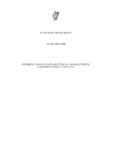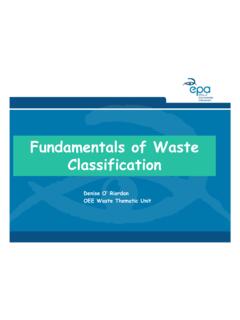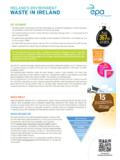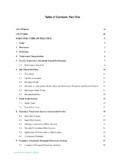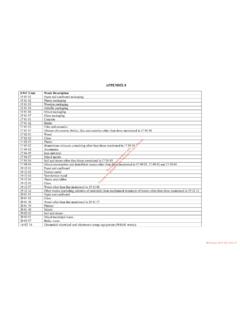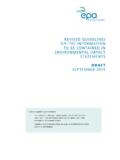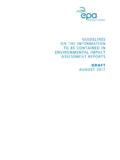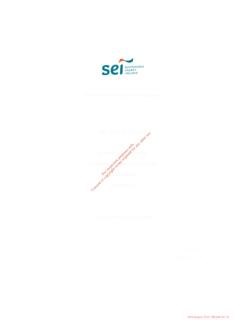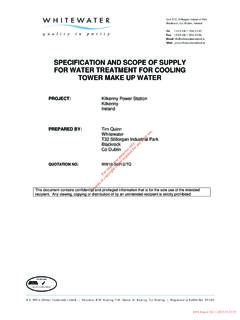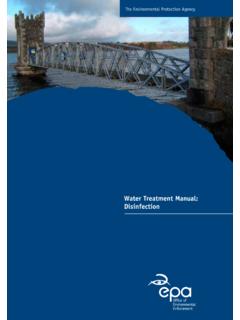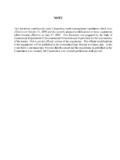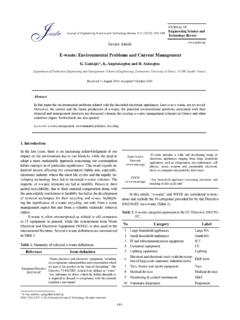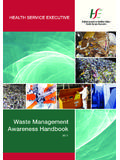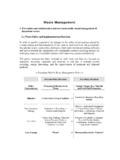Transcription of National Hazardous Waste Management Plan
1 National Hazardous Waste Management PlanNational Hazardous Waste Management Plan2014 2020 Environmental Protection Agency The Environmental Protection Agency (EPA) is a statutory body responsible for protecting the environment in Ireland. We regulate and police activities that might otherwise cause pollution. We ensure there is solid information on environmental trends so that necessary actions are taken. Our priorities are protecting the Irish environment and ensuring that development is sustainable. The EPA is an independent public body established in July 1993 under the Environmental Protection Agency Act, 1992. Its sponsor in Government is the Department of the Environment, Community and Local Government. OUR RESPONSIBILITIES LICENSING We license the following to ensure that their emissions do not endanger human health or harm the environment: Waste facilities ( , landfills, incinerators, Waste transfer stations); large scale industrial activities ( , pharmaceutical manufacturing, cement manufacturing, power plants); intensive agriculture; the contained use and controlled release of Genetically Modified Organisms (GMOs); large petrol storage facilities; Waste water discharges; dumping at sea.
2 National ENVIRONMENTAL ENFORCEMENT Conducting over 1200 audits and inspections of EPA licensed facilities every year. Overseeing local authorities environmental protection responsibilities in the areas of - air, noise, Waste , Waste -water and water quality. Working with local authorities and the Garda to stamp out illegal Waste activity by co-ordinating a National enforcement network, targeting offenders, conducting investigations and overseeing remediation. Prosecuting those who flout environmental law and damage the environment as a result of their actions. MONITORING, ANALYSING AND REPORTING ON THE ENVIRONMENT Monitoring air quality and the quality of rivers, lakes, tidal waters and ground waters; measuring water levels and river flows. Independent reporting to inform decision making by National and local government. REGULATING IRELAND S GREENHOUSE GAS EMISSIONS Quantifying Ireland s emissions of greenhouse gases in the context of our Kyoto commitments.
3 Implementing the Emissions Trading Directive, involving over 100 companies who are major generators of carbon dioxide in Ireland. ENVIRONMENTAL RESEARCH AND DEVELOPMENT Co-ordinating research on environmental issues (including air and water quality, climate change, biodiversity, environmental technologies). STRATEGIC ENVIRONMENTAL ASSESSMENT Assessing the impact of plans and programmes on the Irish environment (such as Waste Management and development plans). ENVIRONMENTAL PLANNING, EDUCATION AND GUIDANCE Providing guidance to the public and to industry on various environmental topics (including licence applications, Waste prevention and environmental regulations). Generating greater environmental awareness (through environmental television programmes and primary and secondary schools resource packs). PROACTIVE Waste Management Promoting Waste prevention and minimisation projects through the co-ordination of the National Waste Prevention Programme, including input into the implementation of Producer Responsibility Initiatives.
4 Enforcing Regulations such as Waste Electrical and Electronic Equipment (WEEE) and Restriction of Hazardous Substances (RoHS) and substances that deplete the ozone layer. Developing a National Hazardous Waste Management plan to prevent and manage Hazardous Waste . Management AND STRUCTURE OF THE EPA The organisation is managed by a full time Board, consisting of a Director General and four Directors. The work of the EPA is carried out across four offices: Office of Climate, Licensing, Research and Resource Use Office of Environmental Enforcement Office of Environmental Assessment Office of Communications and Corporate Services The EPA is assisted by an Advisory Committee of twelve members who meet several times a year to discuss issues of concern and offer advice to the Board. ENVIRONMENTAL PROTECTION AGENCY An Ghn omhaireacht um Chaomhn ComhshaoilPO Box 3000, Johnstown Castle, Co.
5 Wexford, IrelandT +353 53 916 0600 F +353 53 916 0699 E W LoCall 1890 33 55 99 Environmental Protection Agency 2014 National Hazardous Waste Management plan 2014 - 2020 DISCLAIMERThis document does not purport to be and should not be considered a legal interpretation of the legislation referred to every effort has been made to ensure the accuracy of the material contained in this publication, complete accuracy cannot be guaranteed. Neither the Environmental Protection Agency nor the author accepts any responsibility whatsoever for loss or damage occasioned, or claimed to have been occasioned, in part or in full as a consequence of any person acting or refraining from acting, as a result of a matter contained in this publication. All or part of this publication may be reproduced without further permission, provided the source is Hazardous Waste Management plan 2014 - 2020 ISBN 978-1-84095-542-2 Price: E20 Published by the Environmental Protection Agency, IrelandPRINTED ON RECYCLED PAPER| iii Table of ContentsPreface viiExecutive summary viii1.
6 Introduction What can, and cannot, be achieved by this revised plan Structure of this document The objectives of this revised plan Strategic Environmental Assessment & Appropriate Assessment Implementation of the Second plan 62. Hazardous Waste legislation International - Basel Convention on the Control of Transboundary Movements of Hazardous Wastes and their Disposal EU legislation on Hazardous Waste EU Waste Framework Directive Other relevant EU legislation National legislation for Hazardous Waste Classification of Hazardous Waste Emerging issues and recommendations for future consideration Replacement of Regional Waste Management Plans Enforcement Waste Electrical and Electronic Equipment (WEEE) End of Life Vehicles Ozone Depleting Substances / Fluorinated Greenhouse Gases Green Public Procurement Minamata Convention on Mercury Unconventional Gas Exploration and Extraction Recommended changes 223.
7 The National Hazardous Waste profile Managed (reported) Hazardous Waste Management of Hazardous Waste Hazardous Waste treatment in Ireland Hazardous Waste imported for treatment Hazardous Waste exported for treatment Industrial Hazardous Waste generation Unreported Hazardous Waste 37iv | National Hazardous Waste Management plan 2014 - Contaminated soil Extractive Waste Radioactive Waste Enforcement some key challenges concerning Hazardous Waste Waste oils Diesel fuel laundering Waste Electrical and Electronic Equipment (WEEE) and Metal Theft End of life vehicles 414. Prevention of Hazardous Waste Definition of prevention Approach to prevention Role of research and innovation in prevention Prevention plans for prioritised sectors Implementation Qualitative or product-based prevention Role of the National Waste Prevention Programme Local implementation of the prevention plan Potential for all-island co-operation 605.
8 Unreported Hazardous Waste The current situation Commercial Hazardous Waste collection Civic amenity sites (recycling centres) Retail take-back Mobile collection services Recommendations for the improved collection of Hazardous Waste Commercial collection at source Civic amenity sites and recycling centres Producer responsibility and retailer take-back 706. Treatment of Hazardous Waste The current situation Hazardous Waste Projections Self-sufficiency versus export of Hazardous Waste Options proposed as alternative treatment techniques Management of solvents and other wastes currently exported for - thermal treatment Landfill of Hazardous Waste Physico-chemical treatment 88| v Difficult wastes Waste industry business development support Potential for all-island co-operation 917. Legacy issues Closed landfills Contaminated soil Options for Management of contaminated soil in Ireland Harbour sediments Extractive Waste from historical sites 988.
9 Implementation Summary of recommended actions and responsibilities Resource requirements for the revised plan Consequences of not implementing the revised plan Objectives, targets and indicators Reporting schedule 109 APPENDIX A - List of submissions 110 APPENDIX B - Hazardous Waste generation and treatment data 111 APPENDIX C - Hazardous Waste facilities 115 APPENDIX D - Alternative Hazardous Waste treatment techniques 119 APPENDIX E - Radioactive Waste 122 APPENDIX F - Estimated unreported Waste 124vi | National Hazardous Waste Management plan 2014 - 2020| vii PrefaceThis revised National Hazardous Waste Management plan , for the Republic of Ireland, is prepared by the Environmental Protection Agency in accordance with Section 26 of the Waste Management Act 1996 as amended. The first such plan was published in 2001 and was replaced by a second plan published in 2008.
10 This third plan is a revision of the second plan and will cover a period of six years from the date of publication (2014 - 2020).This revised plan sets out the priority actions that should be undertaken within the lifetime of the plan in relation to: the prevention of Hazardous Waste ; improved collection rates for certain categories of Hazardous Waste ; steps that are required to improve Ireland s self-sufficiency in Hazardous Waste Management and the continued identification and regulation of legacy issues ( identification, risk assessment and regularisation of historic unregulated Waste disposal sites). The key to achieving the revised plan s objectives is effective implementation. A number of recommendations are made in the revised plan . Section 26(5) of the Waste Management Act 1996 as amended states the relationship between the revised plan and public bodies: A Minister of the Government, a local authority and any other public authority in whom are vested functions by or under any enactment in relation to the protection of the environment shall have regard to, and in so far as it is considered by the Minister of the Government, local authority or other public authority to be appropriate to do so, shall take measures to implement or otherwise give effect to, recommendation[s] contained in the Hazardous Waste Management plan .
